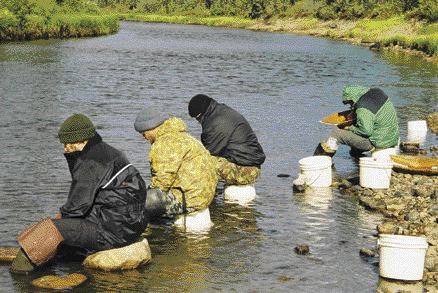“We believe we are onto a new kimberlite field,” Randy Turner, president and CEO of Diamondex, told investors at the recent annual meeting of the Canadian Institute of Mining, Metallurgy and Petroleum in Toronto.
Lena West, located in the Mackenzie River area, is named after Siberia’s Lena River region, home to the Yakutia diamond deposits. Yakutia contains about 800 known kimberlites, including 150 that are diamond-bearing, making it the largest diamond province in Russia.
Diamondex’s ability to generate targets quickly at Lena West is largely attributable to a Russian stream-sediment sampling method capable of pinpointing areas prospective for diamonds on huge tracts of land. The method involves sampling major streams for kimberlite indicator minerals using a hand-carved cedar pan, then gradually homing in on the most promising areas with detailed sampling in the tributaries of streams that bear indicator minerals.
Lena West is particularly amenable to this type of sampling because the area — located 900 km northwest of Yellowknife, N.W.T. — is vast, dotted with numerous lakes, rivers and streams, and has limited quantities of till.
“It’s helped immensely at Lena West,” says David Clarke, vice-president of exploration with Diamondex. “We did our initial reconnaissance in 2002 with only one-hundred samples that showed an area of one-hundred-twenty-five-thousand square kilometres with some interest so we really had to narrow it down. That’s where panning comes in handy.”
Using the panning technique, field technicians sieve a 60-kg sediment sample through a 2-mm mesh screen. Material larger than 2 mm is discarded and the rest is panned to remove the light fraction using a hand-carved cedar pan.
The technique allows for rapid reconnaissance because a crew can identify indicator minerals in the field and follow up promptly, without having to await lab results.
Indicator minerals collected at Lena West are analyzed at the Diamond Research Institute in Russia under the direction of Nikolai Pokhilenko, who played a key role in the discovery of the Snap Lake deposit in the Northwest Territories by Turner’s Winspear Diamonds. Pokhilenko’s team is also credited with the discovery of three diamondiferous kimberlite fields in Yakutia. He has been consulting Diamondex and its predecessor Winspear since 1994.
Last year, a 6-hole drilling program tested three magnetic anomalies at Lena West without encountering any kimberlite. The 60- to 224-metre holes intersected mostly poorly lithified mud-siltstone.
To date, Diamondex has spent $7.8 million on the property and identified 80 geophysical targets ranging in size from 300-1,000 metres in diameter using airborne magnetics. In April, the company used seismic and transient electromagnetic surveys to further define several targets larger than 500 metres in diameter.
The geophysical results are backed by 1,094 stream-sediment samples collected in 2004. These samples yielded four microdiamonds as well as anomalous concentrations of pyrope garnets measuring up to 4 mm and illeminte grains up to 3 mm. Morphological studies on the indicator minerals suggest the samples were taken near the kimberlite source.
During the first phase of this year’s program, Diamondex will complete detailed ground geophysics and 5,000 metres of diamond drilling designed to test airborne and geochemical targets outlined during the 2003 and 2004 field seasons.
A follow-up till and stream-sediment sampling program will resume in early June, when Diamondex will take about 2,000 heavy-mineral-concentrate samples to delineate additional drill targets.
If the results of this year’s drilling are encouraging, Diamondex will proceed with the next stage of exploration: a mini-bulk sample.
The Lena West exploration program is one of several diamond projects taking place in Canada’s Far North, including programs by
— The author is a Toronto-based geologist and freelance writer specializing in mining and the environment. She may be reached by e-mail at heffernan@geopen.com


Be the first to comment on "Diamondex zeros in on Lena West targets"